Creating perfectly balanced handmade soap requires careful attention to fundamentals. Select complementary hard and soft oils to optimize both cleansing and conditioning properties. Use a digital scale and lye calculator for precise measurements every time. Aim for 5-8% superfat to enhance moisture without sacrificing lather. Monitor pH levels with a proper pH meter, not strips. Consider adding acidic additives like lemon juice strategically to adjust alkalinity. These foundational techniques will transform your soap from basic to exceptional.
5 Tips For Perfectly Balanced Handmade Soap
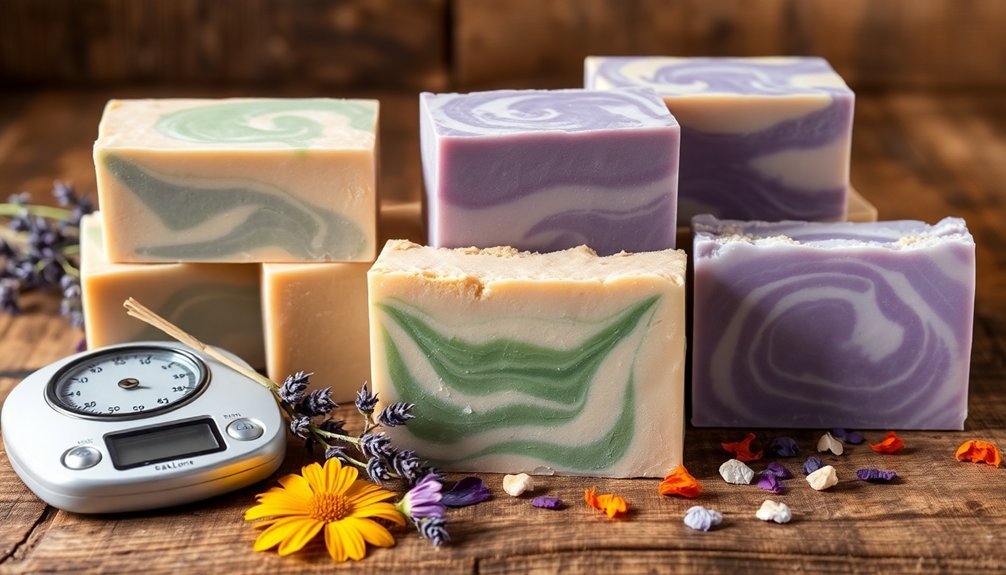
Creating perfectly balanced handmade soap requires understanding the delicate interplay between ingredients.
Start by selecting complementary hard oils (like coconut) and soft oils (like olive) to achieve both robust lather and moisturizing properties in your soap formulation.
Always use a lye calculator to determine precise measurements—this prevents harsh soaps or ineffective cleansers. Aim for a superfat percentage between 5-8% to enhance moisturizing qualities without compromising lather.
Consider how fatty acid profiles affect your final product. Coconut oil contributes cleansing properties while olive oil adds conditioning benefits.
Strategically experimenting with oils allows you to customize hardness, lather quality, and skin feel.
Incorporate additives like sugar or sodium citrate sparingly to boost lather.
Maintaining Precise Measurements for Ph Balance
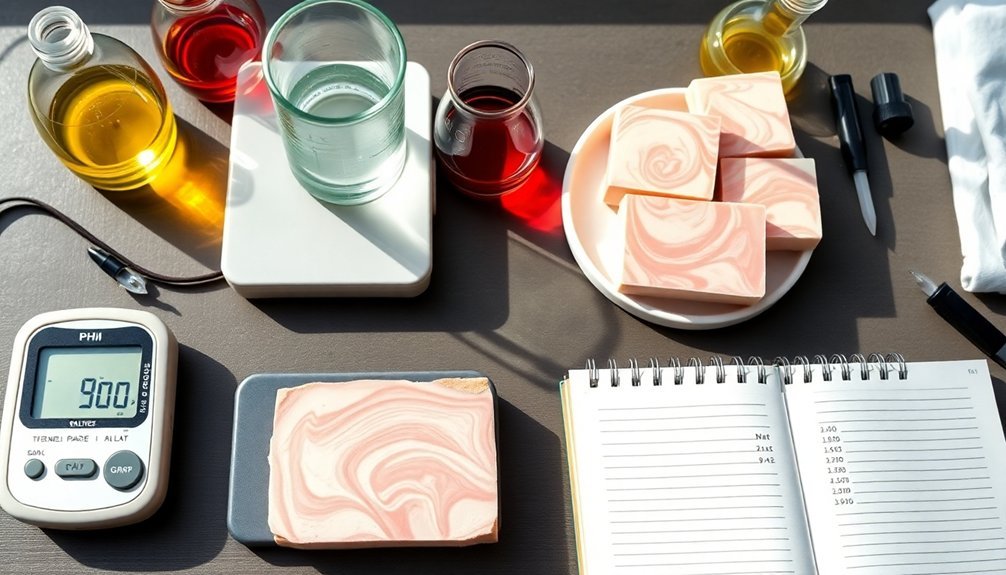
While artistry gives handmade soap its charm, science guarantees its safety through proper pH balance. Your soap's success depends on accurate measurements of lye, oils, and water during the saponification process. Even minor discrepancies can result in soap that's too alkaline or ineffective.
Invest in a quality digital scale that measures in grams for precision that cup measurements simply can't provide. Remember to regularly calibrate your pH meter to avoid misleading readings that could compromise soap quality.
You'll notice pH levels start higher immediately after mixing and gradually decrease during curing. Document all measurements and pH readings in a dedicated notebook.
These records provide valuable insights for making adjustments to future batches, helping you perfect your formula over time.
Strategic Use of Acidic Additives in Soap Formulations
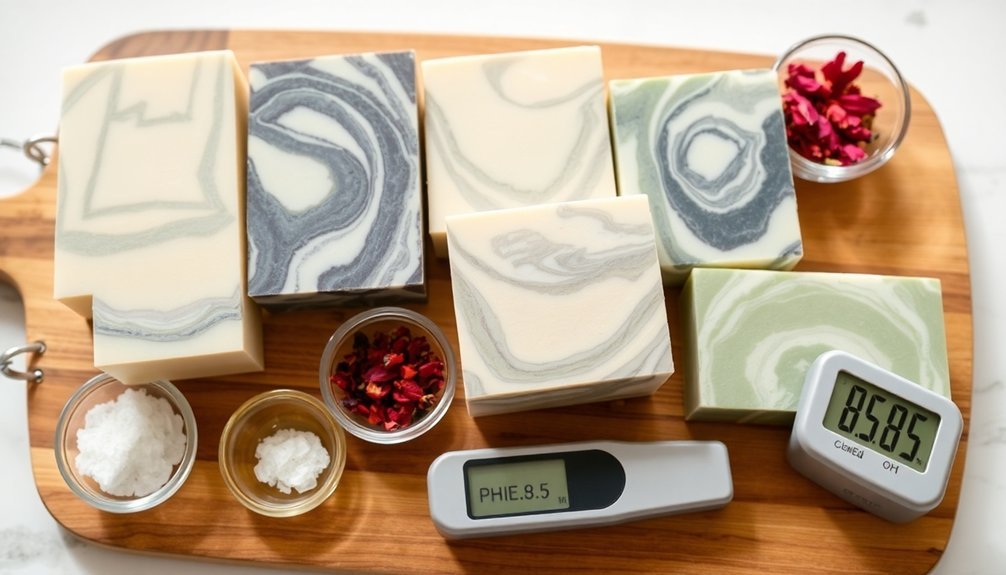
When properly incorporated, acidic additives can transform an overly alkaline soap into a gentle, skin-friendly product. You'll find that adding lemon or lime juice helps lower pH levels while maintaining soap integrity during the saponification process.
If you're rebatching, olive oil effectively neutralizes active lye, potentially reducing pH from 12 to around 8.
- Monitor pH continuously with a pH meter as levels fluctuate throughout saponification
- Experiment with rainwater as your liquid ingredient for naturally lower pH formulations
- Add citric acid crystals cautiously during the rebatching process to avoid creating sludge
- Consider adding olive oil when reformulating harsh soaps to create more balanced products
- Remember that proper pH adjustment creates a more skin-friendly final product without sacrificing cleansing properties
Effective Ph Testing Methods for Handcrafted Soap
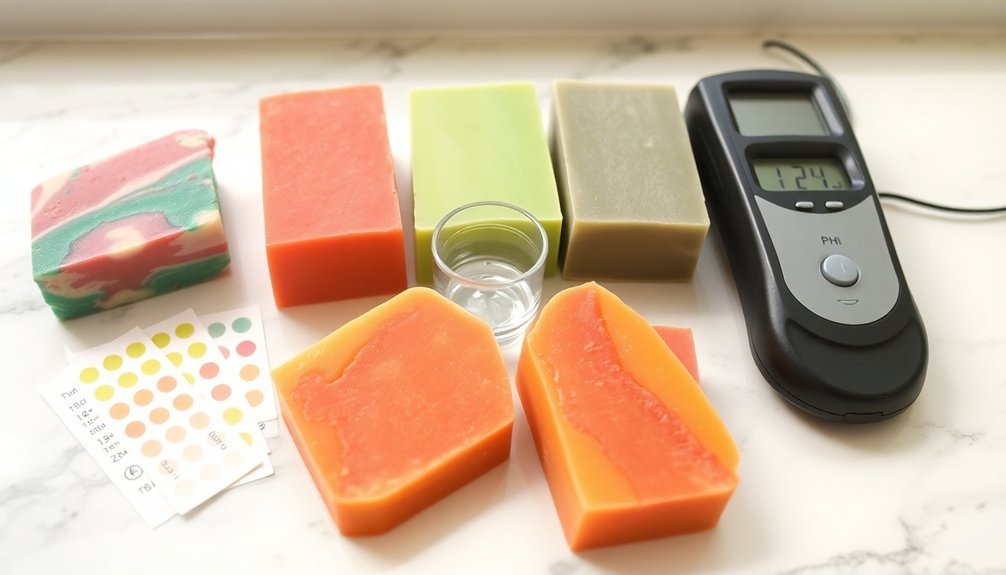
How accurately you measure your soap's pH can make the difference between a harsh, irritating bar and a gentle, skin-nurturing creation.
While pH test strips are common, they're often unreliable for soap testing. Instead, invest in a proper pH meter for precision during your soap-making process.
As saponification progresses, pH levels naturally shift as lye is consumed. Typical lye soap registers between 10-12 on the pH scale.
For the most accurate readings, create a soap slurry using distilled water and test this mixture rather than the solid bar.
Don't forget to regularly calibrate your pH meter according to manufacturer guidelines.
Document your readings and any adjustments you make to formulations. This systematic approach helps you track patterns and refine future batches, ultimately improving your overall soap quality.
Troubleshooting and Adjusting High-Alkalinity Bars
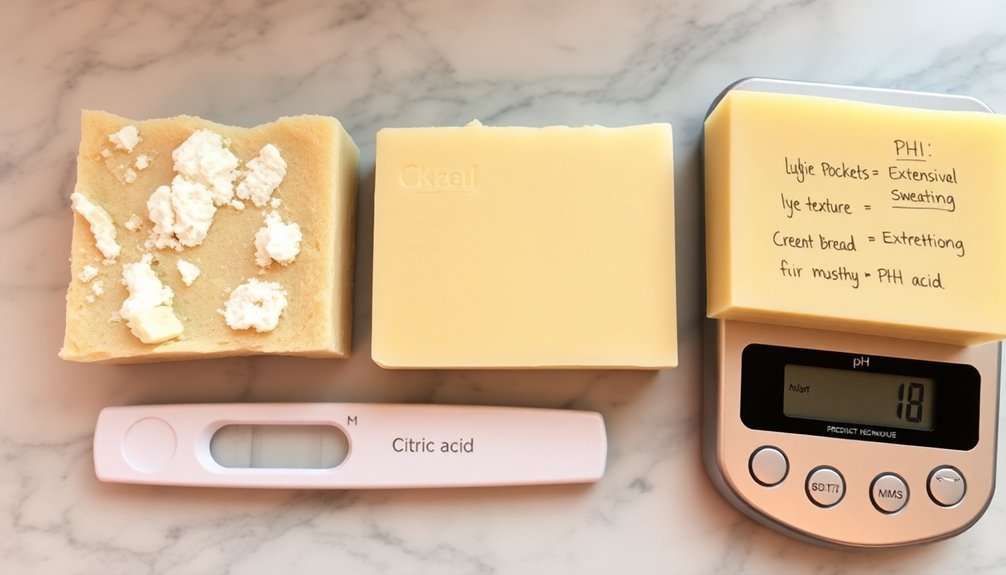
Despite your best efforts, you'll occasionally produce soap with pH levels that are uncomfortably high for skin use. When troubleshooting high-alkalinity bars, consider rebatching with olive oil to neutralize active lye, potentially lowering pH from 12 to a more skin-friendly 8.
Add acidic additives like lemon juice or citric acid sparingly to avoid compromising texture.
- Split test batches to compare adjusted and original formulations
- Monitor pH regularly throughout saponification using a digital pH meter
- Aim for final pH levels between 10-12, which balance cleansing power and skin comfort
- Introduce acidic additives gradually while maintaining proper temperature control
- Remember that pH naturally decreases as lye is consumed during the curing process
Frequently Asked Questions
What Is the Biggest Mistake First Time Soapmakers Make?
You'll likely miscalculate lye amounts in your first soap batch. This critical error leads to either caustic soap that burns or underprocessed soap that's too soft and oily. Always double-check your measurements!
How Do You Make the Best Homemade Soap?
You'll make the best homemade soap by using precise measurements with a digital scale, balancing hard and soft oils, calculating lye correctly, watching for proper trace, and allowing 4-6 weeks for curing.
What Is the Best Oil for CP Soap?
There's no single "best" oil for CP soap. You'll want to blend coconut oil (20-30%) for lather, olive oil for moisture, palm oil for hardness, and a touch of castor oil (5-10%) for stability.
How to Get More Lather in Homemade Soap?
You'll get more lather in homemade soap by increasing coconut oil to 20-30%, adding 5-10% castor oil, dissolving sugar in lye water, using milk or beer as liquid, and reducing your superfat percentage.
In Summary
Creating perfectly balanced handmade soap isn't just art—it's science. You'll get consistently safe, gentle bars when you're measuring ingredients precisely, incorporating acidic additives strategically, and testing pH regularly. Don't panic if your soap is too alkaline; you've got several adjustment methods at your disposal. With these five techniques in your soapmaking toolkit, you're well-equipped to craft beautifully balanced bars that your skin will thank you for.

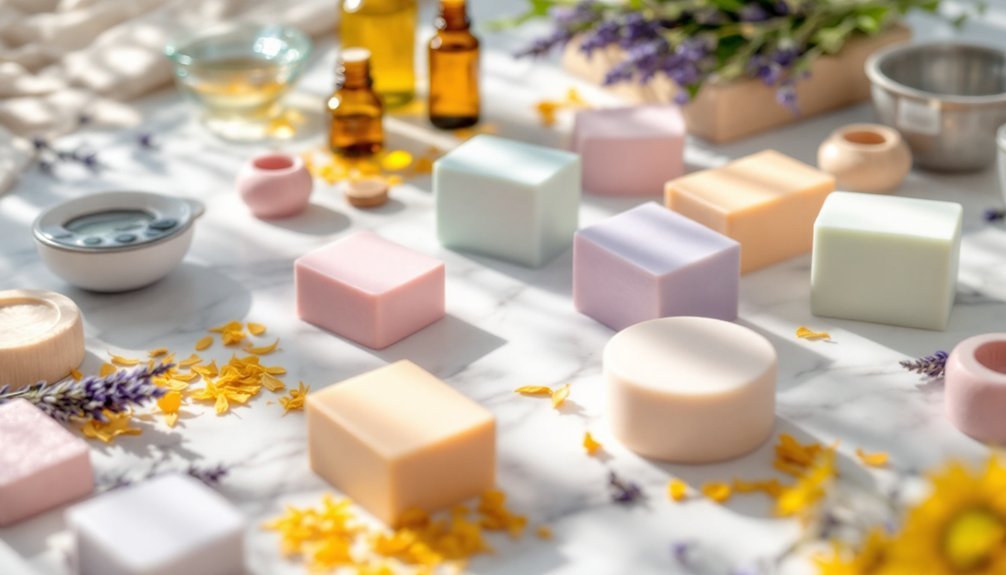



Leave a Reply